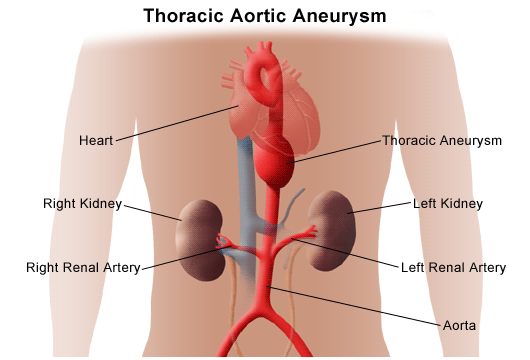Aortic aneurysm
They might suggest an ultrasound screening too especially if you are a. To diagnose an aortic aneurysm your healthcare provider will do a physical exam and an imaging test.
Emdocs Net Emergency Medicine Educationabdominal Aortic Aneurysm Clinical Highlights Updates Emdocs Net Emergency Medicine Education
They can also be hereditary.

. An aneurysm occurs when part of an artery wall weakens allowing it to abnormally balloon out or widen. The normal diameter of the thoracic aorta depends on your age your sex and which part of the thoracic aorta is measured. Painful or difficult swallowing.
Depending on the size of the aortic aneurysm and other factors the aneurysm may press on adjacent organs such as the. Swelling of your arms neck or face. Aortic aneurysms can dissect or rupture.
The prevalence of abdominal aortic aneurysm AAA has been reported to range from 2 to 12 and is found in about 8 of men more than 65 years of age. A pulsating or throbbing feeling in your stomach area. An aortic aneurysm is an enlargement dilatation of the aorta to greater than 15 times normal size.
Pain wherever the aneurysm is growing could be in your neck back chest or abdomen. As an aortic aneurysm grows you might notice symptoms including. Pain in the neck jaw back chest stomach area or shoulder depending on where the aneurysm is located.
Occasionally there may be abdominal back or leg pain. Smoking is the strongest risk factor for aortic aneurysms. The causes of aneurysms are sometimes unknown.
An abdominal aortic aneurysm occurs along the part of. Feeling full after not eating very much. Aortic aneurysms can occur anywhere in the aorta and may be tube-shaped fusiform or round saccular.
Smoking can weaken the walls of the aorta increasing the risk of aortic aneurysm and aneurysm rupture. As with a thoracic aortic aneurysm your doctor can sometimes detect an abdominal aortic aneurysm during a routine exam. An aortic aneurysm is a balloon-like bulge that affects the aorta the main artery that carries oxygen-rich blood directly from the heart to smaller blood vessels in your body.
An aortic aneurysm is a bulge that occurs in the wall of the major blood vessel aorta that carries blood from the heart to the body. This process is called a dissection. An abdominal aortic aneurysm is diagnosed when your abdominal aorta is three centimeters or greater in diameter.
They usually cause no symptoms except when ruptured. Some people are born with them. Aortic disease or an injury may also cause an aneurysm.
An aortic aneurysm is a balloon-like bulge in the aorta the large artery that carries blood from the heart through the chest and torso. Difficulty breathing or shortness of breath. The force of blood pumping can split the layers of the artery wall allowing blood to leak in between them.
The aneurysm forms in the wall of the artery. Shortness of breath if the aneurysm presses on your lung. Feeling full even after a small meal.
The longer and more you smoke or chew tobacco the greater the chances of developing an aortic aneurysm. Abdominal aortic aneurysm risk factors include. Difficulty breathing if it pushes on your trachea or windpipe.

Abdominal Aortic Aneurysm Aaa Familydoctor Org

Abdominal Aortic Aneurysm Aaa United Lincolnshire Hospitals

Abdominal Aortic Aneurysm Aaa Penn Medicine

Aortic Aneurysm Cardiac Surgery Michigan Medicine University Of Michigan

Abdominal Aortic Aneurysm

Aortic Aneurysm Wikipedia

Aortic Aneurysm Bangkok Heart Hospital

Abdominal Aortic Aneurysm Innovative Vascular Groupinnovative Vascular Group

Thoracic Aortic Aneurysm The Patient Guide To Heart Lung And Esophageal Surgery

Aortic Aneurysm Cdc Gov

Thoracic Aortic Aneurysm Johns Hopkins Medicine

Abdominal Aortic Aneurysm Upmc

Aneurisma De Aorta Que Es El Aneurisma De Aorta Portalclinic

Thoracic Aortic Aneurysm Johns Hopkins Medicine

Ascending And Arch Aortic Aneurysms And Dissection Bcm

Abdominal Aortic Aneurysm Medlineplus Medical Encyclopedia

Thoracic Aortic Aneurysm Aortic Dissection Marfan Foundation